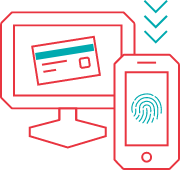KEY TOPICS
POPULAR SEARCHES

Why digital payments?
Billions of dollars in cash payments are made daily in emerging and developing countries, including wages, social transfers, humanitarian relief, and payments to suppliers and farmers. Shifting these payments from cash to digital has the potential to improve the lives of people on low incomes, particularly women. It also means that governments, companies, and international organizations can make and receive payments in a cheaper, safer, and more transparent way, helping to build economies that are inclusive.
Defining digital payments
A digital payment, sometimes called an electronic payment, is the transfer of value from one payment account to another using a digital device or channel. This definition may include payments made with bank transfers, mobile money, QR codes, and payment instruments such as credit, debit, and prepaid cards. Digital payments can be partially digital, primarily digital, or fully digital.
What are the benefits of digital payments?
Digital payments offer significant benefits to individuals, companies, governments, and international development organizations. These benefits include:
-
 Women’s economic participation by giving women more control over their financial lives and providing them greater economic opportunities. For example Reaching Financial Equality for Women is a 10-part action plan to rebuild stronger after COVID-19 by protizing women's financial inclusion.
Women’s economic participation by giving women more control over their financial lives and providing them greater economic opportunities. For example Reaching Financial Equality for Women is a 10-part action plan to rebuild stronger after COVID-19 by protizing women's financial inclusion. -
 Inclusive growth by helping to unlock economic opportunity for the financially excluded and enabling a more efficient flow of resources in the economy. For example, in Bangladesh, digital payments could boost the country’s annual GDP by 1.7 percent. Evidence in Kenya points to the impact of widespread adoption of digital payments on poverty reduction and SDG progress.
Inclusive growth by helping to unlock economic opportunity for the financially excluded and enabling a more efficient flow of resources in the economy. For example, in Bangladesh, digital payments could boost the country’s annual GDP by 1.7 percent. Evidence in Kenya points to the impact of widespread adoption of digital payments on poverty reduction and SDG progress. -
 Transparency and security by enhancing payment traceability and accountability, and reducing corruption and theft as a result. For example, research in the Ghana cocoa sector analyzed the risks (including assault) incurred by individual purchasing clerks in value chains, due to the prevalence of cash. Also, as transparency is a key benefit of digital payments, it is crucial for digital payment providers to be wholly transparent, particularly on pricing, as highlighted in the UN principles for Responsible Digital Payments.
Transparency and security by enhancing payment traceability and accountability, and reducing corruption and theft as a result. For example, research in the Ghana cocoa sector analyzed the risks (including assault) incurred by individual purchasing clerks in value chains, due to the prevalence of cash. Also, as transparency is a key benefit of digital payments, it is crucial for digital payment providers to be wholly transparent, particularly on pricing, as highlighted in the UN principles for Responsible Digital Payments. -
 Financial inclusion by increasing access to a range of financial services, including savings accounts, credit, and insurance products. For example, research from the Bank of International Settlements outlines in detail how digital payments help to advance financial inclusion. Ethiopia’s National Digital Payments Strategy details an ambitious approach on how the responsible digitization of payments can drive financial inclusion and sustained inclusive growth.
Financial inclusion by increasing access to a range of financial services, including savings accounts, credit, and insurance products. For example, research from the Bank of International Settlements outlines in detail how digital payments help to advance financial inclusion. Ethiopia’s National Digital Payments Strategy details an ambitious approach on how the responsible digitization of payments can drive financial inclusion and sustained inclusive growth. -
 Cost savings by providing greater efficiency and speed. For example, implementing treasury single accounts and digitizing revenue collection and payments can generate annual savings of USD1.1 billion for member countries that belong to the Latin American Government Treasury Forum (FOTEGAL). For individuals, especially those in rural and remote areas, digital payments enable access to government transfer programs without traveling long distances or waiting in long lines.
Cost savings by providing greater efficiency and speed. For example, implementing treasury single accounts and digitizing revenue collection and payments can generate annual savings of USD1.1 billion for member countries that belong to the Latin American Government Treasury Forum (FOTEGAL). For individuals, especially those in rural and remote areas, digital payments enable access to government transfer programs without traveling long distances or waiting in long lines. -
 Climate resilience by helping vulnerable individuals and governments to mitigate and adapt to climate and disaster risks. For example, Igniting SDG Progress through Digital Financial Inclusion shows how digital payments can enable access to funds during an emergency, and to make longer-term investments in more resilient and climate-friendly assets and infrastructure.
Climate resilience by helping vulnerable individuals and governments to mitigate and adapt to climate and disaster risks. For example, Igniting SDG Progress through Digital Financial Inclusion shows how digital payments can enable access to funds during an emergency, and to make longer-term investments in more resilient and climate-friendly assets and infrastructure.
Should digital payments replace all cash?
We do not want to abolish physical cash, but rather wish to ensure that people have choice in how they make and receive payments. It is important for people to have digital payment options that are responsible and “better than cash” – for example, a woman can have a payment account in her own name, which she manages. To be clear, we do not want to prevent people from using cash, as sometimes it is the best or only payment option. Governments, businesses, and people are looking for a better value proposition than cash, to improve efficiency, transparency, security, women’s economic participation, financial inclusion, and inclusive growth.
What does it mean to be 'responsible' in digital payments?
To realize their full potential for people and economies, digital payments need to work every time, with effective, timely recourse available if they fail. The terms need to be transparent, and funds and data need to be protected, with accountability when this does not happen. Further, to effectively build sustainable economies, digital payments need to treat all people fairly, and to function across providers so there is competition and choice. These are responsible digital payments.









Digital innovations will continue to improve and grow the payments sector
Digital innovation is continuing to make major improvements in payments and all types of financial service, and the pace of innovation has substantially increased in recent years. The most useful overview of the latest innovations impacting the payments industry is the payments aspect of financial inclusion in the age of fintech, published by the Committee on Payments and Market Infrastructures and the World Bank Group

